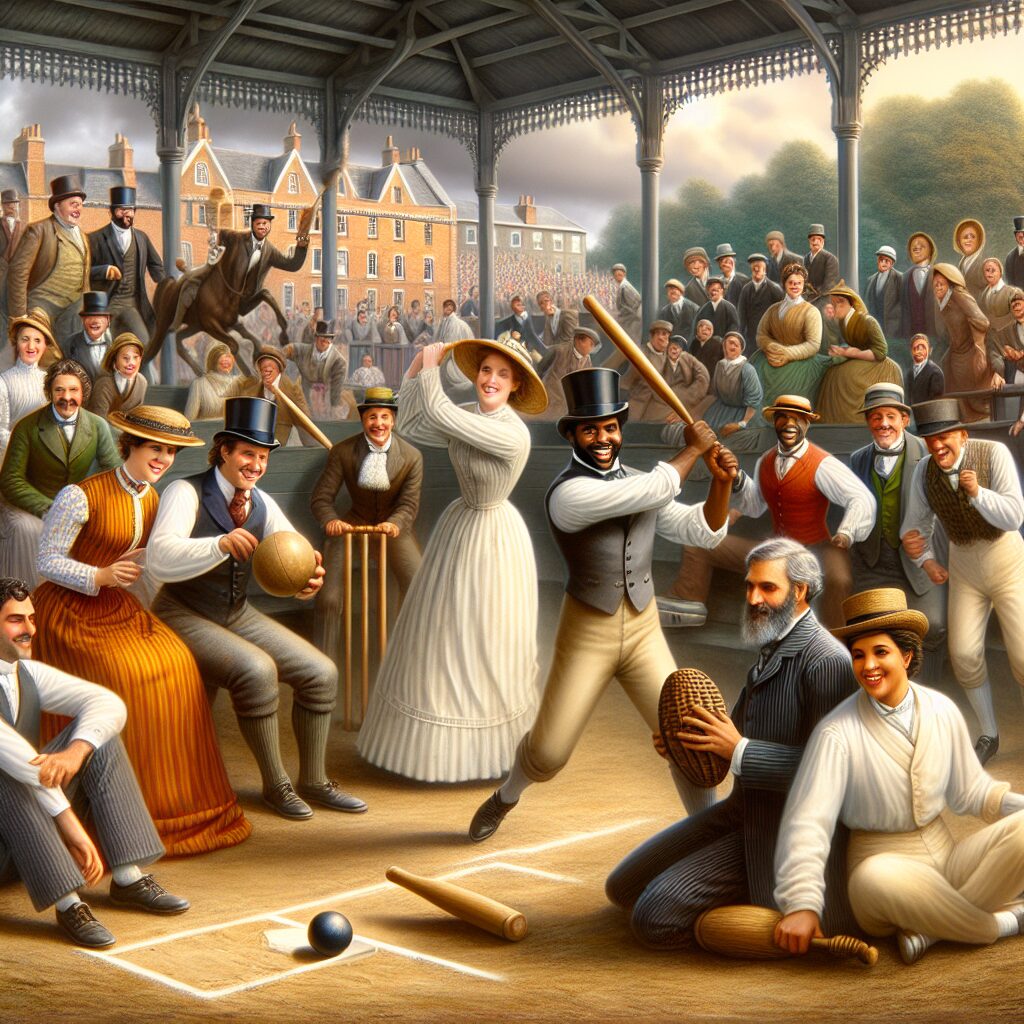The Victorian Era, spanning from 1837 to 1901, was a time of significant advancements and changes in British society. While many aspects of this era are well-known, such as the industrial revolution and the rise of the British Empire, one fascinating aspect that often goes unnoticed is the popularity and significance of ball games during this time. Ball games played a crucial role in the lives of both the upper and lower classes, serving not only as a form of entertainment but also as a way to promote camaraderie and physical fitness. In this article, we will delve into the world of Victorian Era ball games, exploring their unique features and significant impacts on society. By the end, you will gain insights into the fascinating world of these games and how they shaped the Victorian society.
One captivating aspect of Victorian Era ball games was their widespread popularity among people from all walks of life. From the lively streets of London to the sprawling countryside estates, ball games were enjoyed by both the elites and the working class. These games provided much-needed leisure and played a vital role in socializing and networking. Not only did they bring people of various backgrounds together, but they also emphasized the importance of physical activity and health. This great enthusiasm for ball games was fueled by the rejuvenation of sports culture during the Victorian era, as well as the belief that participating in sports could lead to a more productive and morally upright society.
Now, let us explore the key takeaways from the world of Victorian Era ball games. Through this article, we will examine the various types of ball games played during this era, their rules and customs, and the ways in which they influenced British society. Additionally, we will delve into the impact of these games on gender roles, class distinctions, and the overall sense of community. By gaining a deeper understanding of these historic ball games, you will not only appreciate the cultural significance they held but also gain insights into how sports have shaped societies throughout history. So, let us embark on this journey back in time and discover the captivating world of Victorian Era ball games.
Key Takeaways
1. Victorian era ball games were popular recreational activities that reflected the social values and class structure of the time. The upper class engaged in refined sports such as lawn tennis and cricket, while the working class participated in more energetic games like football and rounders.
2. The introduction of organized rules and competitive leagues during the Victorian era laid the foundation for modern sports. These rules standardized game play and created a sense of fair competition, leading to the development of today’s popular sports like football, cricket, and rugby.
3. Gender roles heavily influenced ball games during this era, with women’s participation being limited and often discouraged. However, women found ways to engage in the sports by adapting them to fit societal norms, such as playing cricket with modified rules or participating in archery.
4. Ball games served as both a means of physical exercise and a form of social interaction for the Victorian society. Through these games, people not only improved their fitness and health but also engaged in communal bonding and developed important social skills like teamwork and sportsmanship.
5. The enthusiasm for ball games, particularly among the working class, led to the construction of recreational spaces such as public parks and sports grounds. These new venues provided opportunities for different social classes to come together, fostering a sense of community and offering a much-needed escape from the challenges of industrialization and urbanization.
What were the ball games played during the Victorian Era?
Traditional Victorian Ball Games
During the Victorian Era, a variety of ball games were played which offered entertainment and exercise for both the upper and lower classes. These games served as a popular pastime, showcasing the societal values and providing a glimpse into the lives of people during that time.
One of the most prominent ball games during this era was the Cricket. Played with a bat and ball, it involved two teams taking turns to bat and field. Cricket matches were not only a sporting event but a social gathering as well.
Another well-known game was Tennis. Though the modern version differs, Victorian tennis involved using a solid wooden racket and a leather-covered ball. It was a favorite game of the upper classes and was often played in meticulously maintained gardens.
Rounders was a simpler ball game played by the working-class children. It was a precursor to baseball and involved hitting a small ball with a wooden bat and running around bases to score points.
Innovative Victorian Ball Games
In addition to the traditional ball games, the Victorian Era also witnessed the development of innovative games that incorporated new technologies and ideas. These games gave people opportunities to enjoy leisure time in unique ways.
Croquet emerged as a popular outdoor game that combined elements of golf and billiards. Players used mallets to hit balls through hoops embedded in the grass. It was played on both formal lawns and in more informal settings.
Badminton gained popularity during this era as well. Originating in India, it soon made its way to Britain. Played with a racket, a shuttlecock, and a net, badminton offered a fast-paced and energetic form of entertainment.
Furthermore, the Lawn Tennis was invented during the Victorian Era. Similar to modern tennis, it involved hitting a ball over the net with a racket, but it was played on grass instead of a hard court. This new game quickly caught on and became a fashionable choice among the elite.
The Social Significance of Victorian Ball Games
Ball games during the Victorian Era not only provided physical exercise and enjoyment but also reflected the societal norms and values of the time. These games served as a means of socializing, building connections, and reinforcing class distinctions.
Participating in ball games allowed individuals to demonstrate their sportsmanship, physical prowess, and adherence to etiquette. It provided an opportunity for social interaction, where individuals from different classes could come together and establish connections.
The popularity of certain games also highlighted the aspirations and values of different social classes. For instance, cricket was seen as a game associated with the upper class, emphasizing values of discipline and fair play. On the other hand, games like rounders appealed to the working class, showcasing their more informal and lively play style.
Conclusion
In conclusion, Victorian Era ball games offered a wide range of entertainment options for people of all social classes. Whether it was the traditional games like cricket and tennis or the innovative games like croquet and badminton, these ball games were an integral part of Victorian society, shaping their leisure activities, social interactions, and aspirations.
Numbered Guides for Enjoying Victorian Era Ball Games:
- Find a local club or group that offers Victorian ball game reenactments.
- Explore historical venues or public parks that allow for playing these games.
- Learn the rules and techniques of specific ball games from the Victorian Era.
- Gather friends or family and organize a Victorian-themed ball game tournament.
- Consider wearing period-appropriate clothing to enhance the experience and immerse yourself in the era.
Frequently Asked Questions
1. What were the popular ball games played in the Victorian Era?
The Victorian Era saw the rise of a variety of ball games, including cricket, rounders, and tennis. These games were enjoyed by people of all ages and social classes during that time.
2. Did both men and women participate in Victorian ball games?
Yes, both men and women actively participated in Victorian ball games. While certain games were considered more suitable for one gender, there were still opportunities for both men and women to engage in sports and enjoy these ball games.
3. Were Victorian ball games only limited to outdoor sports?
No, Victorian ball games were not only limited to outdoor sports. Indoor ball games such as table tennis and billiards were also popular during this era. However, outdoor sports received more attention and popularity among the Victorians.
4. How were Victorian ball games different from modern sports?
Victorian ball games had several key differences when compared to modern sports. They often had different rules and equipment, and the style of play was influenced by the social norms and conventions of the Victorian Era. Additionally, the level of professionalism and organization seen in modern sports was not as prevalent during that time.
5. Were Victorian ball games accessible to all social classes?
Victorian ball games were generally accessible to people from different social classes. While certain sports like tennis were often associated with the upper class due to the expense of maintaining the necessary equipment and facilities, games like rounders were played by people from various backgrounds.
6. Did Victorian ball games have any health benefits?
Yes, Victorian ball games provided various health benefits. They promoted physical fitness, endurance, and coordination. Additionally, engaging in these sports allowed individuals to socialize and build camaraderie, contributing to their overall well-being.
7. Were Victorian ball games played strictly for recreation or were there organized leagues?
During the Victorian Era, ball games were initially played for recreation and enjoyment. However, as their popularity grew, organized leagues and competitions emerged. This allowed individuals to showcase their skills and compete with other teams or clubs.
8. How were Victorian ball games influenced by etiquette?
Victorian ball games were heavily influenced by etiquette and decorum. Proper behavior and sportsmanship were emphasized during these games. This included adhering to strict codes of conduct, dressing appropriately, and displaying respectful behavior towards opponents and spectators.
9. What impact did Victorian ball games have on society?
Victorian ball games had a significant impact on society. They promoted a sense of community and unity, allowing people from different backgrounds to come together and engage in friendly competition. These games also provided opportunities for individuals to break societal boundaries and challenge traditional gender roles.
10. Are any Victorian ball games still popular today?
Yes, several Victorian ball games have stood the test of time and remain popular even today. Cricket, for example, is still widely played around the world. Other sports like tennis and rounders have also evolved and continue to be enjoyed by many enthusiasts.
Final Thoughts
Exploring Victorian Era ball games offers us a fascinating glimpse into the past. These games were not merely recreational activities but were deeply entrenched in the social fabric and values of the time. It is intriguing to see how sports have evolved over the years, transcending societal barriers and finding a place in the hearts of people across generations.
The Victorian Era’s ball games set the stage for the development and growth of modern sports. They introduced valuable concepts of team spirit, fair play, and inclusivity that continue to shape the athletic landscape today. The rich legacy of these games reminds us of the enduring power of sports in bringing people together and fostering a sense of camaraderie, both in the past and the present.




